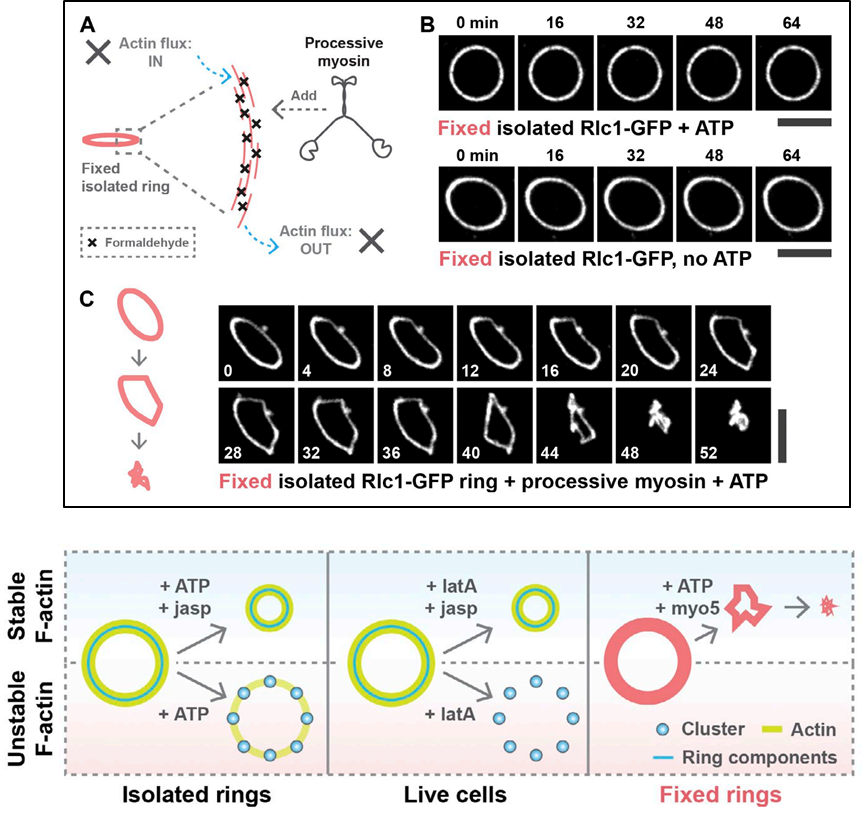黄俊祺课题组在《The Journal of Cell Biology》上发表细胞分裂研究的原创性成果
2018-01
文章来自:admin 阅读次数:2580
胞质分裂(Cytokinesis)是细胞分裂的最后一步,指母细胞的细胞质等在严格调控下被分配到两个子细胞的过程。人和哺乳动物绝大多数细胞的胞质分裂由胞质分裂环(也称细胞分裂环,Cell Division Ring / Actomyosin Ring)介导。胞质分裂环的收缩“切割”一个细胞成两个细胞。异常的胞质分裂能导致多倍体或非整倍体的产生,并可以促进肿瘤的发生。
我院黄俊祺副研究员一直致力于细胞分裂相关机理的研究。长期以来,学界知悉在胞质分裂环收缩期间,其主要成分之一的肌动蛋白(Actin)存在周转(Turnover)现象。然而因缺乏合适的研究切入角度和方法,其周转的具体原因、功能及作用的分子机理未能被很好地揭示。
为了回答这一问题,黄俊祺副研究员与多国研究人员合力攻关,利用激光共聚焦显微镜延时拍摄、体外半分离胞质分裂环技术、量化生物学分析(Quantitative Biological Analysis)及体外诱导福尔马林固定过的半分离胞质分裂环的收缩(如图),发现肌动蛋白周转主要是为了稳定胞质分裂环中丝状肌动蛋白(Filamentous Actin)的长度及维持胞质分裂环的整体收缩效率。
此项研究成果发表在细胞生物学领域的著名杂志The Journal of Cell Biology上(Actin turnover maintains actin filament homeostasis during cytokinetic ring contraction. 2017. DOI: 10.1083/jcb.201701104)。在获得国际同行广泛关注的同时,因其原创性的发现,该研究刚被The Journal of Cell Biology杂志选为近期细胞分裂领域的杰出工作之一,将在2018年01月刊登。
黄俊祺副研究员是该论文的共同第一作者及共同通讯作者。论文的署名单位有:暨南大学Jinan University、英国华威大学 University of Warwick、英国弗朗西斯·克里克研究所Francis Crick Institute、英国伦敦大学国王学院 King’s College London和美国明尼苏达大学 University of Minnesota。

上图:福尔马林固定后的细胞分裂环的收缩
下图:肌动蛋白稳态对细胞分裂环收缩效率影响的机制模式图
文章链接:http://jcb.rupress.org/content/early/2017/06/28/jcb.201701104
原文摘要:
Cytokinesis in many eukaryotes involves a tension-generating actomyosin-based contractile ring. Many components of actomyosin rings turn over during contraction, although the significance of this turnover has remained enigmatic. Here, using Schizosaccharomyces japonicus, we investigate the role of turnover of actin and myosin II in its contraction. Actomyosin ring components self-organize into ∼1-µm-spaced clusters instead of undergoing full-ring contraction in the absence of continuous actin polymerization. This effect is reversed when actin filaments are stabilized. We tested the idea that the function of turnover is to ensure actin filament homeostasis in a synthetic system, in which we abolished turnover by fixing rings in cell ghosts with formaldehyde. We found that these rings contracted fully upon exogenous addition of a vertebrate myosin. We conclude that actin turnover is required to maintain actin filament homeostasis during ring contraction and that the requirement for turnover can be bypassed if homeostasis is achieved artificially.

